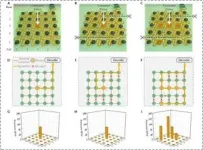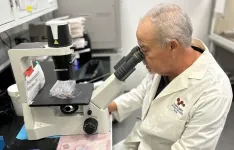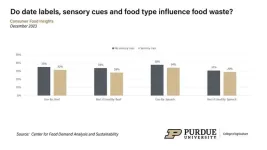(Press-News.org) Researchers from the University of Pennsylvania have discovered key insights into the molecular basis of skin color variations among African populations. Their findings, published in Nature Genetics, broaden the understanding of human evolution and the genetics underpinning contemporary human skin color diversity.
“Despite the abundant genetic diversity within African populations, they have been historically underrepresented in genetic studies,” says senior author Sarah Tishkoff, a Penn Integrates Knowledge University Professor with appointments in the Perelman School of Medicine and School of Arts & Sciences. “Our findings offer novel information about the genetic basis and evolutionary history of skin color diversity, contributing to a clearer depiction of human evolution.”
The story of human evolution is as rich and diverse as the adaptations found across the world’s populations, Tishkoff says. She notes that, among many adaptive traits, skin color stands out as one of the most well-known. Darker skin tones, prevalent in equatorial regions, serve as nature’s very own sunblock, evolving over millennia to shield these populations from the sun’s intense ultraviolet radiation. Conversely, lighter pigmentation, as seen in populations closer to the poles, is an adaptation to mitigate the risks of insufficient sun exposure by maximizing vitamin D production, which is triggered by UV exposure.
Participants gather as Sarah Tishkoff (standing, right) details the purpose of the study. (Image: Courtesy of Alessia Ranciaro)
“Our approach involved genome-wide association studies of skin color from more than 1,500 eastern and southern African individuals as well as scanning the genome to identify genetic variants that are highly differentiated between lightly-pigmented Khoesan-speaking San population and other darkly pigmented Africans and may play a role in local adaptation in that population,” says Yuanqing Feng, first author of the paper and a postdoctoral researcher in the Tishkoff Lab.
The researchers note that pigmentation is a complex trait influenced by hundreds of variants scattered across the genome, with the majority situated in noncoding regions. These noncoding variants may affect the expression of genes located up to one million bases away. The vast number of mutations associated with skin color and the uncertainty surrounding the target genes regulated by these mutations make it particularly arduous for researchers to find the precise genetic mechanisms governing this trait.
Feng and collaborators used massively parallel reporter assays to discern the regulatory activities of thousands of variants. This high-throughput technique narrowed down the thousands of candidates to 165 functional variants. To identify the target genes of these functional variants, Feng further constructed high-resolution chromatin interaction maps in melanocytic cells using chromatin conformation capture assays. “This is a high-resolution 3D genome map in melanoma cells that will be valuable for gene regulation studies in pigmentation and melanoma biology,” Feng says.
Using CRISPR/Cas9-based genome editing, the researchers discovered that mutations in an enhancer of OCA2, a gene associated with albinism, could lead to a 75% reduction in melanin levels when compared to control cells. Within the same OCA2 enhancer, the researchers identified two closely located regulatory variants, estimated to be 1.2 million years old and 57 thousand years old, with the latter coinciding with the period of human migration from Africa.
A member of Tishkoff’s research team draws blood from a participant to extract the genetic information that will inform the study. (Image: Courtesy of Sarah Tishkfoff)
“This case illustrates the continuous evolution of human skin color, and it’s remarkable to observe the significant effects on skin pigmentation attributed to a single enhancer," Feng says.
San people have relatively lighter pigmentation compared to other African populations and possess the oldest genetic lineages in humans. While it is hypothesized that the light skin color of the San may result from adaptation to a southern African environment, the genetic underpinnings of this adaptation remain elusive. The researchers pinpointed several crucial regulatory variants near MITF, LEF1, and TRPS1 that contribute to the skin color adaptation observed in the San.
“MITF, LEF1, and TRPS1 are involved in signaling pathways regulating both melanocyte differentiation and hair development,” Tishkoff says. “This suggests that the variants influencing the lighter skin pigmentation observed in the San people may also contribute to their distinctive hair morphology.” Notably, the variant near TRPS1 associated with lighter skin color is at nearly 100% frequency in the San and in most non-Africans, whereas the variant associated with darker skin color is common in most other African populations and in the darkly pigmented Melanesian population, a striking example of global adaptations to UV exposure.”
Additionally, the researchers found a novel gene impacting human skin pigmentation, CYB561A3, which regulates iron homeostasis and influences melanin levels in melanocytic cells. “To our knowledge, the role of CYB561A3 in skin pigmentation has not been reported before. Intriguingly, there have been reports linking intravenous iron infusion to skin hyperpigmentation. Given that CYB561A3 encodes an iron reductase, I am curious about the role of this protein in this process,” Tishkoff says.
“Our findings underscore the complexity of genetic factors influencing skin color and the benefits of including ethnically diverse and underrepresented populations in genetic studies,” she says. “Conducting functional studies on the impact of noncoding variants will enhance our comprehension of the genetics underlying complex human traits and disease risk.”
“The populations included in this study are from remote regions of Africa and required the use of a mobile lab set up in the field sites,” Tishkoff says. “The collaboration with our partners in Africa was key to the success of this research project.”
In future research, the Tishkoff lab would like to use its innovative functional genomics approach to identify more genetic variants contributing to human pigmentation and other adaptive traits in a larger sample of ethnically diverse Africans.
Sarah Tishkoff is the David and Lyn Silfen University Professor in Genetics and Biology and a Penn Integrates Knowledge University Professor with appointments in the Perelman School of Medicine’s Department of Genetics and Department of Medicine and in the School of Arts & Sciences’ Department of Biology at the University of Pennsylvania.
Yuanqing Feng is a postdoctoral fellow in the Tishkoff lab at Penn.
Other authors include Ning Xie, Chao Zhang, Fang Zhang, and Matthew E.B. Hansen of Penn; Fumitaka Inoue of Kyoto University; Shaohua Fan of Fudan University; Thomas Nyambo of Hubert Kairuki Memorial University; Sununguko Wata Mpoloka and Gaonyadiwe George Mokone of the University of Botswana; Charles Fokunang and Alfred K. Njamnshi of the University of Yaoundé; Gurja Belay of Addis Ababa University; Michael S. Marks of the Children’s Hospital of Philadelphia Research Institute; Elena Oancea of Brown University; and Nadav Ahituv of the University of California, San Francisco.
This research was supported by the National Institutes of Health (grants R35GM134957-01, 3UM1HG009408-02S1, 1R01GM113657-01, 5R01AR076241-02, and 1S10OD010786-01) and the Penn Skin Biology and Disease Resource-based Center (Grant NIH P30-AR069589).
END
More than skin deep: A molecular look at the mechanisms behind pigmentation variation
A new collaborative study offers a better understanding of genes and variants responsible for skin color, providing insights into human evolution and local adaptation.
2024-01-12
ELSE PRESS RELEASES FROM THIS DATE:
Guantanamo Bay: 22 years of indefinite detention and eroded human rights
2024-01-12
Media contacts:
Jillian McKoy, jpmckoy@bu.edu
Michael Saunders, msaunder@bu.edu
##
BOSTON, MA – January 11, 2024 marks the 22nd anniversary of the opening of the Guantanamo Bay detention camp, a facility shrouded in controversy and synonymous with indefinite detention and alleged human rights abuses. Established in the wake of the 9/11 attacks, Guantanamo has held hundreds of individuals suspected of terrorism, many without charge or trial, and under conditions widely condemned by international human rights organizations.
A Legacy of Controversy:
Indefinite Detention: Over ...
Integrative Center for Alternative Meat and Protein to launch at UC Davis Jan. 17
2024-01-11
The University of California, Davis, is leading the establishment of a new Integrative Center for Alternative Meat and Protein, or iCAMP. The center will work toward large-scale commercialization and technological advancement of alternative proteins, including cultivated meat (from animal cells grown in large fermentors), plant- and fungal-based foods, and innovative hybrids that combine conventional meat products with alternative proteins.
Bringing together leading researchers and academic institutions, industry ...
Even the oldest eukaryote fossils show dazzling diversity and complexity
2024-01-11
(Santa Barbara, Calif.) — The sun has just set on a quiet mudflat in Australia’s Northern Territory; it’ll set again in another 19 hours. A young moon looms large over the desolate landscape. No animals scurry in the waning light. No leaves rustle in the breeze. No lichens encrust the exposed rock. The only hint of life is some scum in a few puddles and ponds. And among it lives a diverse microbial community of our ancient ancestors.
In a new account of exquisitely preserved microfossils, researchers at UC Santa Barbara and McGill University revealed that eukaryotic organisms had already evolved into a diverse array ...
UTEP researchers discover compound that fights leukemia, lymphoma
2024-01-11
EL PASO, Texas (Jan. 11, 2024) – Researchers at The University of Texas at El Paso have identified a novel pharmaceutical compound that successfully kills leukemia and lymphoma cancer cells, potentially paving the way for new forms of therapy.
Renato Aguilera, Ph.D., a professor in the Department of Biological Sciences, is the principal investigator on the project that identified the promising compound, called thiophene F-8. His team’s findings were recently published in the research journal PLOS One.
“The main ...
C-path to lead new task force aimed at accelerating drug development for mitochondrial and inherited metabolic diseases
2024-01-11
TUCSON, Ariz., January 11, 2024 — Critical Path Institute (C-Path) today announced the launch of a task force focused on accelerating drug development for mitochondrial and inherited metabolic diseases. The task force will lay the groundwork for specific solutions, offering valuable insights that aim to contribute to regulatory decision-making.
C-Path’s demonstrated expertise will be leveraged to ensure success, specifically its track record in generating tangible solutions that have accelerated drug development in rare and pediatric ...
Molecularly designing polymer networks to control sound damping
2024-01-11
The world is filled with a myriad of sounds and vibrations—the gentle tones of a piano drifting down the hall, the relaxing purr of a cat laying on your chest, the annoying hum of the office lights. Imagine being able to selectively tune out noises of a certain frequency. Researchers at the University of Illinois Urbana-Champaign have synthesized polymer networks with two distinct architectures and crosslink points capable of dynamically exchanging polymer strands to understand how the network connectivity and bond exchange mechanisms govern the overall damping behavior of the network. The incorporation of dynamic bonds into the polymer network demonstrates ...
Year-end survey spotlights food safety, age-related consumer behavior, out-of-stock trends
2024-01-11
WEST LAFAYETTE, Ind. — Building off the previous month’s survey, the December 2023 Consumer Food Insights Report digs deeper into the relationships between food-date labels and the decision to discard food. The report also explores generational differences in food behaviors and reviews 2023 trends for out-of-stock items and common foods that people reported limiting in their diets over the year.
The survey-based report out of Purdue University’s Center for Food Demand Analysis and Sustainability assesses food spending, consumer satisfaction and values, support ...
Mike Norvell named 2023 Paul “Bear” Bryant Coach of the Year
2024-01-11
HOUSTON, January 10, 2024 – Mike Norvell, head coach at Florida State University, was named college football Coach of the Year at the American Heart Association’s Paul “Bear” Bryant Awards, presented by Marathon Oil. The 38th annual awards program benefits the American Heart Association, the world’s leading voluntary health organization devoted to a world of longer, healthier lives for all.
In his fourth season as the head coach at Florida State, Norvell led the Seminoles to a 13-1 overall record and an 8-0 mark in the Atlantic Coast Conference (ACC). Norvell was previously honored as the ACC Coach of the Year and was ...
Study reveals wastewater surveillance is key tool in keeping schools open during public health emergencies
2024-01-11
Wastewater surveillance is a potent tool in understanding COVID-19 transmission within school settings, according to a ground-breaking study led by epidemiologist David Larsen from Syracuse University.
The research team’s work that was published recently in PLOS Global Public Health establishes the pivotal role of wastewater analysis in managing the public health response to COVID-19 at schools.
The study focused on a middle and high school campus in Jefferson County, New York, serving 600 students and compared results from wastewater surveillance to COVID-19 case trends. The surveillance ...
Loss of executive function may signal onset of neurodegenerative condition FXTAS
2024-01-11
New UC Davis research shows that men with an FMR1 premutation who experienced reduced executive function were at higher likelihood of developing fragile X-associated tremor/ataxia syndrome (FXTAS).
FXTAS is a progressive genetic condition that causes movement issues and cognitive decline. These findings, published in the journal Movement Disorders, could help clinicians determine which premutation carriers will eventually develop FXTAS.
“There's converging evidence that the premutation is affecting certain circuits in the brain ...
LAST 30 PRESS RELEASES:
MAN PPK2: A “universal” enzyme for the production of RNA building blocks
Sniffing out the cause of keratoderma-associated foot odor
Tuning color through molecular stacking: A new strategy for smarter pressure sensors
Humans use local dialects to communicate with honeyguides
Theory-breaking extremely fast-growing black hole
ŌURA and National University of Singapore open Joint Lab to advance research in personalized preventive health
Hope for smarter lung cancer care
Singapore scientists discover lung cancer's "bodyguard system" - and how to disarm it
Bacteria use wrapping flagella to tunnel through microscopic passages
New critique prompts correction of high-profile Yellowstone aspen study, highlighting challenges in measuring ecosystem response to wolf reintroduction
Stroke survivors miss critical treatment, face greater disability due to systemic transfer delays
Delayed stroke care linked to increased disability risk
Long term use of anti-acid drugs may not increase stomach cancer risk
Non-monetary 'honor-based' incentives linked to increased blood donations
Natural ovulation as effective as hormones before IVF embryo transfer
Major clinical trial provides definitive evidence of impacts of steroid treatment on severe brain infection
Low vitamin D levels shown to raise risk of hospitalization with potentially fatal respiratory tract infections by 33%
Diagnoses of major conditions failing to recover since the pandemic
Scientists solve 66 million-year-old mystery of how Earth’s greenhouse age ended
Red light therapy shows promise for protecting football players’ brains
Trees — not grass and other greenery — associated with lower heart disease risk in cities
Chemical Insights scientist receives Achievement Award from the Society of Toxicology
Breakthrough organic crystalline material repairs itself in extreme cold temperatures, unlocking new possibilities for space and deep-sea technologies
Scientists discover novel immune ‘traffic controller’ hijacked by virus
When tropical oceans were oxygen oases
Positive interactions dominate among marine microbes, six-year study reveals
Safeguarding the Winter Olympics-Paralympics against climate change
Most would recommend RSV immunizations for older and pregnant people
Donated blood has a shelf life. A new test tracks how it's aging
Stroke during pregnancy, postpartum associated with more illness, job status later
[Press-News.org] More than skin deep: A molecular look at the mechanisms behind pigmentation variationA new collaborative study offers a better understanding of genes and variants responsible for skin color, providing insights into human evolution and local adaptation.





